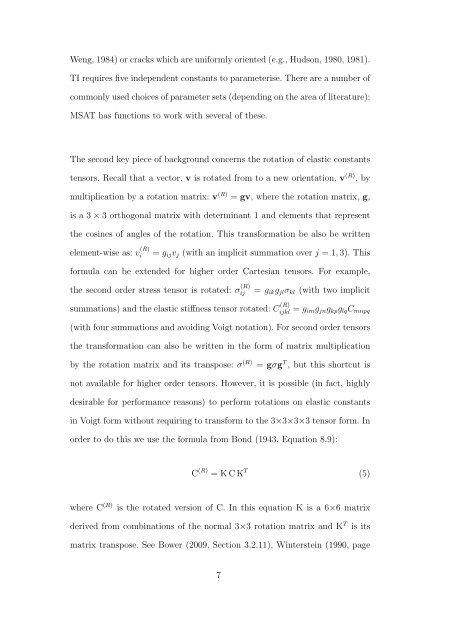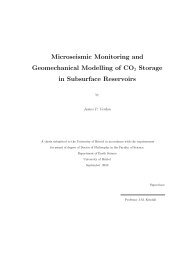MSAT - University of Bristol
MSAT - University of Bristol
MSAT - University of Bristol
Create successful ePaper yourself
Turn your PDF publications into a flip-book with our unique Google optimized e-Paper software.
Weng, 1984) or cracks which are uniformly oriented (e.g., Hudson, 1980, 1981).<br />
TI requires five independent constants to parameterise. There are a number <strong>of</strong><br />
commonly used choices <strong>of</strong> parameter sets (depending on the area <strong>of</strong> literature);<br />
<strong>MSAT</strong> has functions to work with several <strong>of</strong> these.<br />
The second key piece <strong>of</strong> background concerns the rotation <strong>of</strong> elastic constants<br />
tensors. Recall that a vector, v is rotated from to a new orientation, v (R) , by<br />
multiplication by a rotation matrix: v (R) = gv, where the rotation matrix, g,<br />
is a 3 × 3 orthogonal matrix with determinant 1 and elements that represent<br />
the cosines <strong>of</strong> angles <strong>of</strong> the rotation. This transformation be also be written<br />
element-wise as: v (R)<br />
i<br />
= g ij v j (with an implicit summation over j = 1, 3). This<br />
formula can be extended for higher order Cartesian tensors. For example,<br />
the second order stress tensor is rotated: σ (R)<br />
ij<br />
= g ik g jl σ kl (with two implicit<br />
summations) and the elastic stiffness tensor rotated: C (R)<br />
ijkl = g img jn g kp g lq C mnpq<br />
(with four summations and avoiding Voigt notation). For second order tensors<br />
the transformation can also be written in the form <strong>of</strong> matrix multiplication<br />
by the rotation matrix and its transpose: σ (R) = gσg T , but this shortcut is<br />
not available for higher order tensors. However, it is possible (in fact, highly<br />
desirable for performance reasons) to perform rotations on elastic constants<br />
in Voigt form without requiring to transform to the 3×3×3×3 tensor form. In<br />
order to do this we use the formula from Bond (1943, Equation 8.9):<br />
C (R) = K C K T (5)<br />
where C (R) is the rotated version <strong>of</strong> C. In this equation K is a 6×6 matrix<br />
derived from combinations <strong>of</strong> the normal 3×3 rotation matrix and K T<br />
is its<br />
matrix transpose. See Bower (2009, Section 3.2.11), Winterstein (1990, page<br />
7











